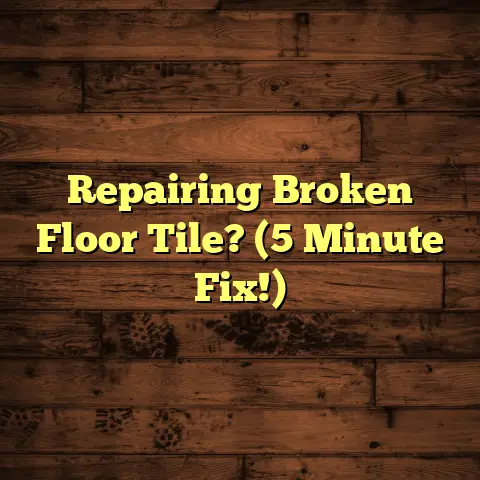Tile Removal Time: What to Expect? (5 Hour Limit!)
But what if I told you there’s a “best option” for tile removal that could get the job done in a reasonable timeframe – maybe even within a five-hour limit? Sounds good, right? Let’s dive into how to make that happen!
Section 1: Understanding Tile Removal
1. Overview of Tile Types
First off, not all tiles are created equal. The type of tile you’re dealing with dramatically affects how long it takes to remove it.
-
Ceramic Tile: This is your average, everyday tile. It’s generally easier to remove than porcelain because it’s less dense.
-
Porcelain Tile: Porcelain is tougher and more water-resistant than ceramic. That also means it’s tougher to remove. Expect to spend more time on these guys.
-
Vinyl Tile: Usually the easiest to remove, especially if it’s the peel-and-stick kind. However, older vinyl tiles can be glued down pretty stubbornly.
-
Natural Stone Tile (Granite, Marble, Slate): These are dense and can be brittle. Removal can be tricky because you want to avoid damaging the subfloor.
Why does the type of tile matter? Well, a softer ceramic tile might chip away easily, while a dense porcelain tile might require more forceful methods and specialized tools.
2. Common Reasons for Tile Removal
Why are you even thinking about removing tile? Is it an upgrade, a repair, or just a style change?
-
Upgrades: Maybe you’re tired of the dated look and want something more modern.
-
Repairs: Cracked or broken tiles can be an eyesore and a safety hazard.
-
Style Changes: Trends change, and what was in style 10 years ago might not be now.
-
Water Damage: Leaks can cause tiles to loosen and the subfloor to rot.
The reason behind the removal can influence your approach. For example, if you’re just replacing a few cracked tiles, you’ll be more careful to avoid damaging the surrounding tiles. But if you’re doing a full remodel, you might be a bit more aggressive.
3. Challenges in Tile Removal
Tile removal isn’t always a walk in the park. Here are some common challenges I’ve faced:
-
Adhesive Types: Some adhesives are super strong and make tiles incredibly difficult to budge. Mastic, thin-set mortar, and epoxy are common culprits.
-
Subfloor Damage: Sometimes, in the process of removing tiles, you might accidentally damage the subfloor. This can add extra time and cost to the project.
-
Labor Intensity: Let’s be honest, tile removal is hard work. It can be tough on your back, knees, and hands.
-
Dust and Debris: Prepare for a lot of dust! It gets everywhere and can be a health hazard if you’re not careful.
-
Accessibility: Tight spaces or awkward angles can make tile removal even more challenging.
These challenges can seriously impact your timeline. A stubborn adhesive or unexpected subfloor damage can easily add hours to your project.
Section 2: Preparing for Tile Removal
1. Tools and Materials Needed
Having the right tools is crucial for efficient tile removal. Here’s a list of essentials:
- Safety Goggles: Protect your eyes from flying debris.
- Gloves: Protect your hands from sharp edges and adhesive.
- Dust Mask or Respirator: Protect your lungs from dust.
- Chisel: For breaking up and lifting tiles.
- Hammer: For striking the chisel.
- Tile Cutter or Score: For scoring grout lines.
- Scraper: For removing adhesive residue.
- Shop Vacuum: For cleaning up dust and debris.
- Buckets or Trash Bags: For disposing of the old tiles.
Optional tools that can enhance efficiency:
-
Electric Chisel (Demo Hammer): This tool can significantly speed up the removal process, especially for large areas. You can rent these at most tool rental places.
-
Floor Scraper with Long Handle: Saves your back when removing adhesive.
-
Grout Removal Tool: Makes removing grout easier and faster than using a chisel.
2. Safety Precautions
Safety first! Tile removal can be hazardous, so take these precautions:
- Wear safety goggles, gloves, and a dust mask or respirator.
- Ensure proper ventilation. Open windows and use a fan to circulate air.
- Be aware of sharp tile edges. Handle broken tiles with care to avoid cuts.
- Protect your knees. Use knee pads or a cushion.
- Be mindful of dust. Silica dust from tile and grout can cause respiratory problems.
3. Planning the Project
A well-thought-out plan is essential to staying within that five-hour limit.
-
Assess the area: Measure the square footage to estimate the amount of tile you need to remove.
-
Gather your tools and materials: Make sure you have everything you need before you start.
-
Protect the surrounding areas: Cover nearby walls and furniture with plastic sheeting to protect them from dust and debris.
-
Create a timeline: Break down the project into smaller tasks and estimate how long each will take.
-
Consider the disposal: Have a plan for disposing of the old tiles.
Section 3: The Tile Removal Process
1. Step-by-Step Guide to Removing Tiles
Here’s a step-by-step process for removing tiles efficiently:
-
Preparation:
- Clear the area of all furniture and obstacles.
- Cover surrounding surfaces with plastic sheeting.
- Put on your safety gear (goggles, gloves, mask).
-
Grout Removal:
-
Use a grout removal tool or a chisel and hammer to remove the grout around the tiles. This will make it easier to lift the tiles.
-
Tile Removal Techniques:
-
Manual Method: Place the chisel at an angle under the edge of the tile. Strike the chisel with the hammer to break the tile free from the adhesive. Work your way around the tile until it comes loose.
- Power Tool Method: Use an electric chisel (demo hammer) to break up the tiles. Hold the chisel at an angle and let the tool do the work. Be careful not to damage the subfloor.
-
Adhesive Removal:
-
Use a scraper to remove any remaining adhesive from the subfloor. A floor scraper with a long handle can save your back.
-
Cleanup:
-
Vacuum up all the dust and debris.
- Dispose of the old tiles properly.
2. Techniques for Efficient Tile Removal
-
Work in small sections: Focus on removing a few tiles at a time. This will help you stay organized and avoid getting overwhelmed.
-
Use the right angle: When using a chisel, experiment with different angles to find the most effective way to lift the tiles.
-
Apply consistent pressure: When using a power tool, apply consistent pressure and let the tool do the work. Avoid forcing it.
-
Take breaks: Tile removal is physically demanding. Take breaks to avoid fatigue and prevent injuries.
3. Dealing with Stubborn Tiles
Sometimes, you’ll encounter tiles that just won’t budge. Here are some strategies:
-
Apply heat: Use a heat gun or hair dryer to soften the adhesive.
-
Use a solvent: Apply a solvent like mineral spirits or adhesive remover to the edges of the tile. Let it sit for a few minutes to loosen the adhesive.
-
Score the tile: Use a tile cutter or score to create lines across the tile. This will weaken the tile and make it easier to break up.
-
Use a bigger hammer: Sometimes, you just need a little more force. Be careful not to damage the subfloor.
If you’re still struggling, it might be time to call in a professional. Spending hours wrestling with one stubborn tile can throw your whole timeline off.
Section 4: Post-Removal Considerations
1. Cleaning Up After Tile Removal
Cleaning up is just as important as the removal itself.
-
Vacuum thoroughly: Use a shop vacuum to remove all dust and debris from the area. Pay attention to corners and crevices.
-
Wipe down surfaces: Wipe down the walls and any other surfaces that may have collected dust.
-
Dispose of debris properly: Bag up the old tiles and dispose of them according to your local regulations.
2. Assessing the Subfloor
Once the tiles are gone, take a close look at the subfloor.
-
Check for damage: Look for cracks, holes, or signs of rot.
-
Level the surface: Use a level to check for uneven spots.
-
Repair any damage: Fill cracks and holes with patching compound. Level any uneven spots with self-leveling compound.
3. Preparing for New Flooring
A smooth, clean subfloor is essential for installing new flooring.
-
Clean the subfloor: Vacuum and wipe down the subfloor to remove any remaining dust and debris.
-
Apply a primer: Apply a primer to the subfloor to improve adhesion for the new flooring.
-
Follow the manufacturer’s instructions: Follow the manufacturer’s instructions for installing your new flooring.
Conclusion: Final Thoughts on Tile Removal Time
So, can you really remove tile in five hours? It depends on the size of the area, the type of tile, and your skill level. But with the right tools, techniques, and a solid plan, it’s definitely possible to make significant progress in that timeframe.
Remember, the “best option” for tile removal is the one that gets the job done efficiently, safely, and with minimal damage to your home. Don’t be afraid to call in a professional if you’re feeling overwhelmed or unsure.
Good luck with your tile removal project!





